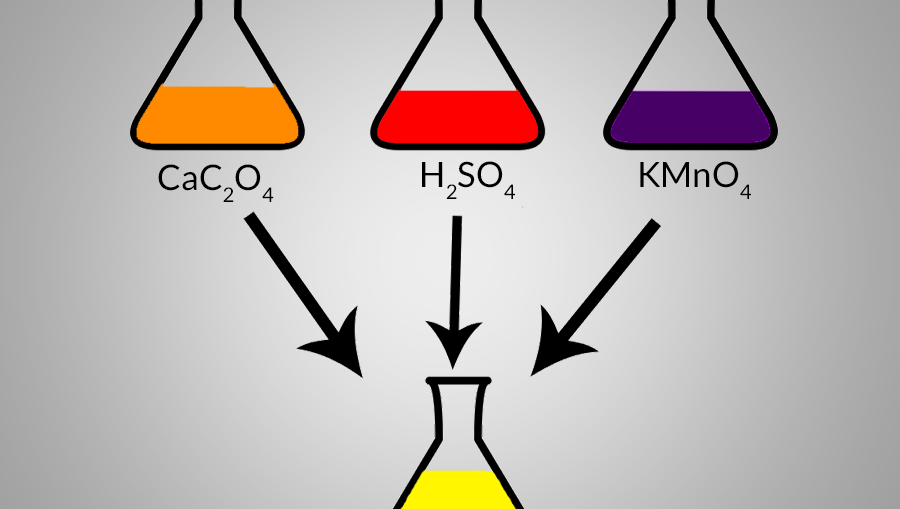Calcium oxalate, Sulfuric Acid, and Potassium Permanganate (CaSO4 H2SO4 KMnO4) are very common chemicals all around the world. These three chemicals react with each other. The reaction is called the Redox reaction. Mainly the CaC2O4 and KMnO4 react with each other while the sulfuric acid just creates an acidic environment.
About Calcium Oxalate, Sulfuric Acid and Potassium Permanganate (CaC2O4 H2SO4 KMnO4)
Calcium oxalate is a salt of calcium with the chemical formula CaC₂O₄.
On the other hand, Diluted Sulfuric acid is a mineral acid. It is a colorless, odorless, and syrupy liquid that is soluble in water. The Diluted Sulfuric Acid acts only as an acid in this chemical reaction.
Potassium Permanganate is a purple color reagent having the chemical formula KMnO4

Balancing the reaction among CaC2O4, H2SO4, and KMnO4
After balancing the reaction equation among CaC2O4 H2SO4 KMnO4 of the reaction-
5CaC2O4 + 2KMnO4 + 8H2SO4 = K2SO4 + 5CaSO4 + 2MnSO4 + 10CO2 + 8H2O
The oxidation state of the carbon of CaC2O4 in the above reaction increased. At the same time the oxidation state of the Mn atom of KMnO4 decreases in the above reaction. Because they donate as well as accept electrons during the chemical reaction. That means there is an exchange of electrons happens. As the electron exchange takes place at this reaction, this chemical reaction is an oxidation-reduction reaction.
Since the reaction is a redox reaction, this chemical reaction can easily be balanced by using the ion-electron method. So let’s get started.
Oxidizing agent: CaC2O4
Reducing agent: KMnO4 or, MnO4 -1
Oxidation Half Reaction
The oxidizing agent, CaC2O4 in the above reaction releases two electrons and formed carbon dioxide. These two electrons readily are accepted by the Mn atom in the reducing agent. The oxidation half-reaction for the above redox reaction takes a shape like as bellow-
CaC2O4 – 2e = Ca2+ + 2CO2 … … … … … … … .. (i)
Reduction Half Reaction
As we talked about it in the above paragraph the Mn+7 in the oxidizing agent, MnO4 -1 accepts five electrons released by the reducing agent CaC2O4 and becomes Mn2+ ion. Therefore, the reduction half reaction for the above reaction becomes-
MnO4 -1 + 5e + 8H+ = Mn2- + 4H2O … …. …. …. (ii)
Since the oxidation half, as well as the reduction half-reaction occurs at the same time and they, are part of the same redox reaction, therefore we must add both half-reactions together to get the full redox reaction. But in the oxidation half-reaction, two electrons are released whereas in the reduction half-reaction five electrons are accepted. So to balance the above oxidation-reduction reaction we should multiply the oxidation half-reaction with 5 as well as reduction half-reaction with 2. Then by adding both equations we will get the balanced oxidation-reduction reaction. So why do late? let’s do it.
Here, Equation (i)x5 + Equation (ii)x2,
5CaC2O4 – 10e = 5Ca2+ +10CO2
2MnO4 -1 +10e + 16H+ = 2Mn2- + 8H2O
5CaC2O4 + 2MnO4 -1 + 16H+ = 5Ca2+ + 2Mn2- + 8H2O + 10CO2
Adding necessary ions and radicals we get,
5CaC2O4 + 2KMnO4 + 8H2SO4 = K2SO4 + 5CaSO4 + 2MnSO4 + 8H2O + 10CO2
Follow us on Twitter, Facebook, Linkedin and Tumbler
Click to readily understand ion-electron balancing redox reaction-


Leave a Reply